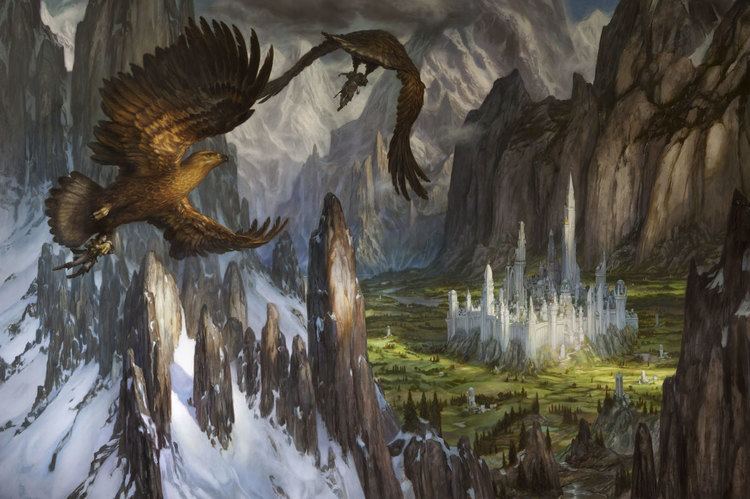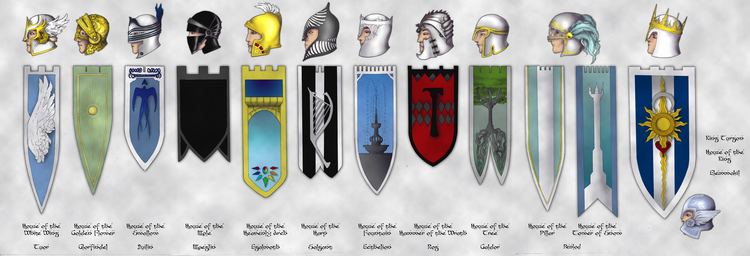Ruler Turgon Lifespan First Age | Location north of Beleriand Founder Turgon | |
 | ||
Other name(s) Ondolindë (The Rock of the Music of the Water)
Gar Thurion (Secret Place)
Gondobar (City of Stone)
Gondothlimbar (City of the Dwellers in Stone)
Gwarestrin (Tower of the Guard)
Gondost (Stone Fortress) Type Hidden kingdom-city of Turgon
Fortified, Hidden City Notable locations the Seven Gates, the Vale of Tumladen, the Encircling Mountains | ||
Lotr fall of gondolin focus series
Gondolin is a fictional city in J. R. R. Tolkien's legendarium, inhabited by Elves. Found and founded with divine inspiration, it is hidden by mountains and endures for centuries before being betrayed and destroyed.
Contents
- Lotr fall of gondolin focus series
- Siege of gondolin third age total war
- The Fall of Gondolin
- Internal history
- The Seven Gates of the City
- The End of the City
- The Seven Names of Gondolin
- The Houses of Gondolin
- The tongue of Gondolin
- Weaponry
- References

Siege of gondolin third age total war
The Fall of Gondolin

The city is first described in The Fall of Gondolin which was the foundational completed tale for all of Tolkien's Middle-earth stories. The story was read aloud by Tolkien to the Exeter College Essay Club in the spring of 1920.
Internal history
Gondolin was founded by King Turgon in the First Age. It was originally named Ondolindë. According to The Silmarillion, the Vala Ulmo, the Lord of Waters, revealed the location of the Vale of Tumladen to Turgon in a dream. Under this divine guidance, Turgon travelled from his kingdom in Nevrast and found the vale. Within the Echoriath, the Encircling Mountains, lay a round level plain with sheer walls on all sides and a ravine and tunnel leading out to the southwest known as the Hidden Way. In the middle of the vale there was a steep hill which was called Amon Gwareth, the "Hill of Watch". There Turgon decided to found a city, designed after the city of Tirion in Valinor that the Noldor had left.
Turgon and his people built Gondolin in secret. After it was completed, he took with him to dwell in the hidden city his entire people in Nevrast — almost a third of the Noldor of Fingolfin's House — as well as nearly three quarters of the northern Sindar.
The Seven Gates of the City
The Hidden Pass was protected by seven gates, all constantly guarded; the first of wood, then stone, bronze, iron, silver, gold, and steel. The seven gates of Minas Tirith echoed this notion of a layered defense on a hill.
The End of the City
The city stood for nearly 400 years until it was betrayed to Morgoth by Maeglin, Turgon's nephew. Maeglin was captured while mining outside the Encircling Mountains (against Turgon's orders). Maeglin betrayed the location of Gondolin after being promised Lordship and Turgon's daughter Idril. Morgoth then sent an army over the Crissaegrim the northern most precipitous and dangerous portion of the Encircling Mountains during The Gates of Summer (A great Gondolin festival) catching them unawares and sacking the city with relative ease. In addition to orcs, Balrogs and dragons, Melkor's (Morgoth's) army, in early versions of the story, included iron machines (tank) powered by "internal fires" and used as personnel carriers, to surmount difficult geographic obstacles and to defeat fortifications.
The Fall of Gondolin closely resembles that of Troy.
The Seven Names of Gondolin
According to "The Book of Lost Tales" the city had seven names: "’Tis said and ’tis sung: Gondobar am I called and Gondothlimbar, City of Stone and City of the Dwellers in Stone; Gondolin the Stone of Song and Gwarestrin am I named, the Tower of the Guard, Gar Thurion or the Secret Place, for I am hidden from the eyes of Melko; but they who love me most greatly call me Loth, for like a flower am I, even Lothengriol the flower that blooms on the plain."
The Houses of Gondolin
According to "The Book of Lost Tales" the active male Elves of Gondolin belonged to one of the eleven "Houses" or Thlim plus the bodyguard of Tuor which was accounted the twelfth:
The tongue of Gondolin
In the hidden city of Gondolin, an isolated land, a peculiar Elvish dialect developed: "This differed from the standard (of Doriath) (a) in having Western and some Northern elements, and (b) in incorporating a good many Noldorin-Quenya words in more or less Sindarized forms. Thus the city was usually called Gondolin (from Q. Ondolin(dë)) with simple remplacement of g-, not Goenlin or Goenglin [as it would have been in standard Sindarin]". The common or standard Sindarin tongue was not used in Gondolin.
Weaponry
The smiths of Gondolin, using Elven techniques and magics, made powerful magic blades. In The Hobbit, the swords Orcrist, Glamdring and a long dagger later named Sting were found in a Rhudaur Troll-Hoard. Each of these weapons had the ability to detect Goblins/Orcs in the immediate vicinity by glowing blue. They also had the property of striking fear in the hearts of Orcs when used against them in combat. All were well-crafted, and extraordinarily sharp. Apparently, Gondolinian weapons were impervious to rust and corrosion, as the examples found in the trolls' lair were over six thousand years old and had been hanging in the lair for an indeterminate length of time, yet were sharp and ready for use when unsheathed.
The dagger Sting was known to have special powers against giant spiders (distant offspring of Ungoliant) and could cut their webs with ease. It also was highly effective against Shelob, cutting the spider's eyes and wounding her sufficiently that she fled in pain. Whether the longer Gondolin swords mentioned in Tolkien's works had similar powers versus spiders is unknown. Such creatures were common in the Ered Gorgoroth south of Gondolin.
